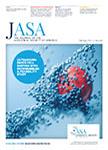版权所有:内蒙古大学图书馆 技术提供:维普资讯• 智图
内蒙古自治区呼和浩特市赛罕区大学西街235号 邮编: 010021

作者机构:Multiscale Modeling and Simulation Lab. CNRS Laboratoire MSMS Faculté des Sci. UPEC 61 Ave. du gal de Gaulle Creteil 94010 France guillaume.haiat@univ-paris-est.fr
出 版 物:《The Journal of the Acoustical Society of America》
年 卷 期:2015年第138卷第3_SUPPLEMENT期
页 面:1799-1799页
学科分类:07[理学] 082403[工学-水声工程] 08[工学] 070206[理学-声学] 0824[工学-船舶与海洋工程] 0702[理学-物理学]
摘 要:Dental implants are widely used for oral rehabilitation. However, there remain risks of failure that are difficult to anticipate. The objective of this study is to investigate the potentiality of quantitative ultrasound (QUS) to assess dental implant implant stability. To do so, the implant is initially completely inserted in the proximal part of a bovine humeral bone sample. The 10 MHz ultrasonic response of the implant is then measured and a quantitative indicator I is derived based on the rf signal obtained. Then, the implant is unscrewed by 2π radians and the measurement is realized again. The procedure is repeated seven times and the indicator is derived after each rotation of the implant. Analysis of variance (ANOVA) (p 10−5) tests revealed a significant effect of the amount of bone in contact with the implant on the distribution of I. In parallel, a finite element model is developed in order to model the ultrasonic propagation in the implant surrounded by bone tissue. The results show the feasibility of our QUS device to assess implant primary stability. A good agreement is obtained between experimental and numerical results. This study paves the way for the development of a new approach in oral implantology.